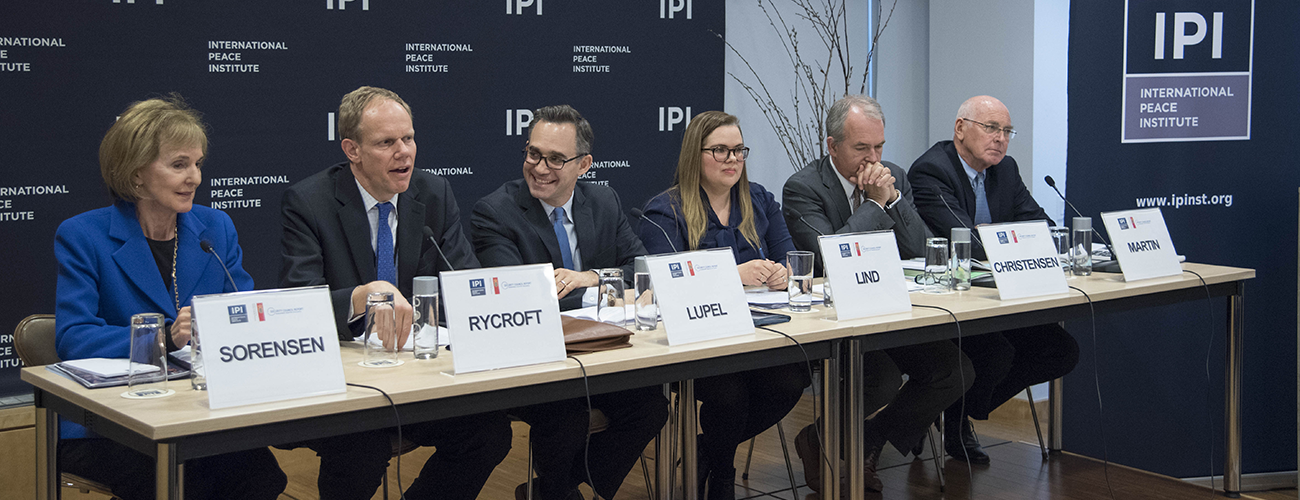An IPI audience heard high praise for the United Nations’ response to “a rapidly changing international society fuelled by social media and a much more active and engaged public,” from Peter Martin Lehmann Nielsen, Chargé d’Affaires of Denmark to the UN. Mr. Lehmann Nielsen was referring to the unprecedented transparency of the UN’s 2016 secretary-general selection process.
Panelists at the April 6th examination of the 2016 race for the office of secretary-general agreed that it was the most transparent to date, with a stronger role played by civil society and the UN General Assembly than ever before.
Matthew Rycroft, Permanent Representative of the United Kingdom to the UN, credited the open nature of the 2016 selection with ensuring a positive outcome, saying, “Added transparency was not only a good thing in its own right, but it dramatically increased the chances of the strongest candidate being elected—and it reduced, to an impossible minimum, the risk of a stitch-up in favor of a less effective candidate.”
Minna-Liina Lind, Deputy Permanent Representative of Estonia to the UN, offered the Accountability, Coherence, Transparency (ACT) group’s perspective on the matter, saying, “The only problem was the relationship between the GA and the Security Council. We had hoped for regular briefings from the Security Council about the results, but everything else from our position paper took place.”
Ms. Lind’s attitude towards the increased transparency and engagement with civil society reflected that of Ambassador Rycroft’s appraisal of Antonio’s Guterres, and she closed by saying, “We wanted to create a process that would give us the best secretary-general, and I think we did that.”
Gillian Sorensen railed against the traditionally insular and opaque system by which previous secretaries-general had been chosen, saying, “Whatever experienced diplomats, or others, might have thought about who the next secretary-general might be, that was of no relevance. People were fed up with the secretive process that had existed for 70 years.”
Ms. Sorensen, a former Assistant UN Secretary-General, argued the “wave of support” for increased inclusiveness in the search secretary-general was rooted in the push for a first woman secretary-general. She noted that both The New York Times and The Washington Post printed op-eds in advocating for “opening up the process, and considering a woman secretary-general” in the run-up to the 2016 selection itself.
Ian Martin, Executive Director of Security Council Report, reminded the crowd that there are many questions still to be answered around the issue of secretary-general selection, asking, “Should only member states be allowed to nominate a candidate for secretary-general? Is it clear that candidates can be nominated by member states other than their own? What is the process for withdrawal? Are straw polls the best way, rather than formal, private votes?”
Mr. Martin warned that, “The more we’ve begun to discuss the lessons learned, the more clear it is that however major the advances were, there are still issues that it’s important to consider well ahead of the next process.” Emphasizing the importance of addressing these lingering questions, he said, “On the one hand, there can be no way back to a process that is not transparent. On the other hand, this process does not work well for a reappointment process.”
Tomas Christensen, Chef de Cabinet for the Office of the President of the General Assembly (PGA), said he felt that “engagement of the member states and the global public” will be even more important during the next selection. Mr. Christensen attributed the success of the UN in this regard to the role played by former PGA Mogens Lykketoft.
Mr. Christensen noted that Mr. Lykketoft “took it upon himself” to promote several instruments of transparency, including the introduction of town-hall-style meetings with the candidates, and the posing of questions from civil society.
“Inclusivity is a power tool in a struggle with the member states to get things moving,” Mr. Christensen pointed out. “Mr. Lykketoft understood this very well, and so designed the involvement of civil society and groups like IPI, thereby creating a movement around the process,” he said.
Imparting an important lesson from the 2016 selection, Mr. Christensen finished by saying, “You won’t have Lykketoft around the next time. If you don’t have a PGA, and a crew around the PGA, who can distill sentiments into letters and policies—the next time around might be a totally different story.”
The event was co-hosted by the Permanent Mission of Denmark to the United Nations, and the Security Council Report.
The discussion was moderated by IPI Vice President Adam Lupel.








